Happy Thanksgiving from Rene, Howard, Eliot and Lois at the most amazing place to celebrate the holiday. #BartonG puts on a show like no other. We are forever grateful. Join us next year. We already reserved a long table in the garden. @Barton Weiss








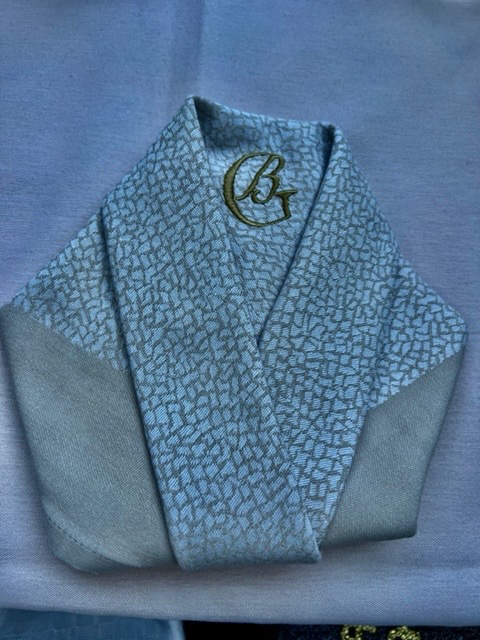






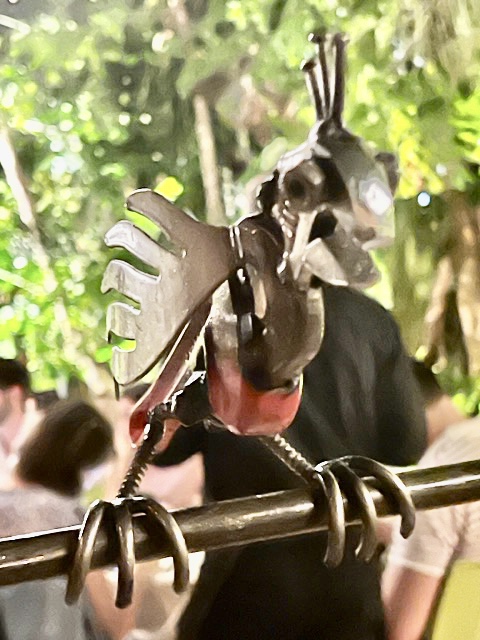
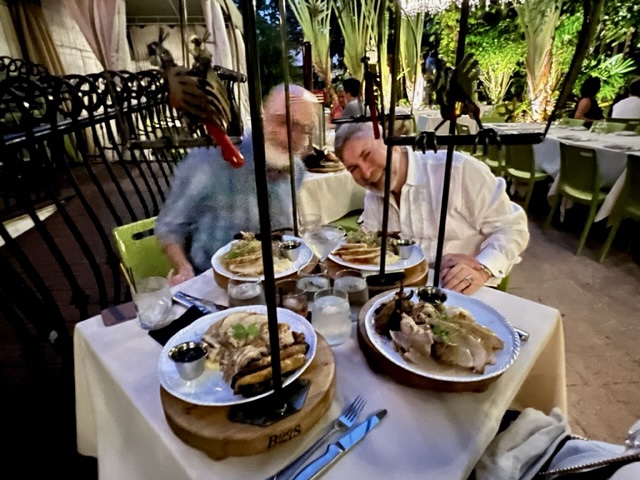



Happy Thanksgiving from Rene, Howard, Eliot and Lois at the most amazing place to celebrate the holiday. #BartonG puts on a show like no other. We are forever grateful. Join us next year. We already reserved a long table in the garden. @Barton Weiss





















Kris Jenner is art directing her own Forbes photo shoot.
“That’s cute!” Jenner, 66, beams at one of her shots on a nearby monitor, while pointing out the area she wants retouched (her neck). The “momager” of the Kardashian empire–a word to which Jenner holds the trademark–expertly poses, shifting angles for the photographer. Her face is meticulously done in the family’s signature makeup of inky eyelashes, nude lips and impeccable contour, a look the New Yorker writer Jia Tolentino called “Instagram face” for its ubiquity and popularity.
It’s an early September day, still summer, and this midtown Manhattan studio provides a cave-like respite from the heat. Good thing. Jenner came with her “glam squad”—her two on-call hair and makeup people—along with her PR person and two security guards, one whose job seems to be holding her designer bag. She’s in a black suit and bodysuit (from Good American and Skims, companies run by her daughters, natch), topped off with black leather gloves (which she never takes off), Chanel platform loafers and massive sparkling hoop earrings. She radiates the same power and glamor exuded by her celebrity daughters: Kim Kardashian, Khloe Kardashian, Kourtney Kardashian, Kylie Jenner and Kendall Jenner.
The directing, the styling, the constant photo-readiness: it’s all part of the careful choreography surrounding Jenner and her daughters. In town for Fashion Week, Jenner spent it hobnobbing with Dee Ocleppo Hilfiger (spouse of Tommy Hilfiger), Sex and the City creator Candace Bushnell and earlier that day, lifestyle doyenne Martha Stewart. She squeezed in this photo and video shoot plus a 20-minute interview with Forbes—granting us a total of one hour of her time—before jetting off on a private plane headed back home. It’s a rare up-close look inside Jenner’s highly calibrated world, a level of coordination that’s evidence of not only the matriarch’s authority, but also the machinery that has helped her turn the Kardashians’ fame into a multi-billion-dollar empire.
“I’m the one who can help them [her kids] identify what it is that they want to do, help them create a business, build an infrastructure and help them focus,” Jenner says.
“Kris Jenner is an unstoppable force,” says Ryan Seacrest, who green-lit the family’s reality TV show. He adds that she “led her family to succeed in creating an empire bigger than anything we could have ever imagined when we came up with the show’s concept 15 years ago.”
Back then Jenner, at age 51, forever changed the reality TV landscape with the October 14, 2007, premiere of Keeping Up With The Kardashians on the E! network. It delivered an insider’s view of the family’s trials and tribulations, along with some outrageous moments, including when Kourtney and Kim came to blows in the season 18 premiere, leaving Kim bleeding. The show ran for 20 seasons, airing 285 episodes in total and ended in 2021.
“The Kardashians are human brands.”Markus Wohlfeil
This year it rebooted on Hulu, its new streaming home, with a zippy new name: The Kardashians. Hulu claims the show’s April debut was the most-watched series premiere in the U.S., but didn’t disclose viewer numbers. According to streaming analytics compiler Entertainment Strategy Guy, however, the Hulu premiere didn’t break into the top ten of any major trackers for hours watched, including Nielsen. But the fact that Jenner turned the family into a household name and her kids into entrepreneurs, all after she turned 50, earns her a spot on Forbes’ second annual 50 Over 50 List celebrating women who prove that success has no age limit.
Although she usually provides behind-the-scenes support, putting her daughters out front (in their TV show’s first season, Jenner attained instant meme status by telling Kim, “You’re doing great, sweetie!” as her daughter posed nude in a Playboy shoot), she’s emerging as the face of her own brands. Her Safely cleaning products company, for example, was born of her insatiable drive to keep her home spotless. Setting it apart from the Methods and Windexes of the world, Jenner says, are the products’ plant-based formulation, which she says are a first in the category. “Kris is such an incredible partner because she’s truly a fully immersed participant in every component,” Safely cofounder Emma Grede tells Forbes. The two women created Safely with model and cookbook author Chrissy Teigen in March 2021, though Teigen left several months later, following revelations on social media that she’d bullied TV personality Courtney Stodden, who was a teenager at the time. (Teigen publicly apologized.) Jenner owns an estimated 7% of the company, which raised an undisclosed amount of funding from investors led by venture capital firm Imaginary Ventures (also a backer of Kim Kardashian’s wildly successful Skims). In February, Safely rolled out its products in 1,700 Walmart stores; it’s also available through Bed Bath & Beyond and Amazon. Neither Grede nor Jenner would comment on its revenues.
Her six children (there’s son Rob, plus five daughters) harnessed their reality TV show fame and tremendous social media influence—they have a billion followers combined—to help start 15 businesses. “They’re human brands,” says Markus Wohlfeil, a marketing professor at De Montfort University in Leicester, England, who studies celebrity fandom and consumer behavior. “You [the fans] basically see them as an ideal friend, ideal mate, ideal partner. So all of your projection of your own desires [onto the Kardashians] is basically how they appear to you,” he tells Forbes, describing the connection they form with fans through their TV show and constant use of social media. “It just gives the illusion they’re very close,” he says, adding that the Kardashian brand then expands through their products. Jenner, Wohlfeil says, is like a modern-day Steve Jobs or Walt Disney. “She’s one of those people who sees individual parts and can actually put them together.”
According to multiple industry sources, Jenner, who sits on the board of each of her kids’ businesses, gets 10% of gross revenue from every product, TV show or modeling gig in which her family participates, in exchange for helping build out staffing and supply chains. “Each one of our businesses has an individual infrastructure and a team built around the company,” she says. It’s an arrangement she made with them at the start. “I said to my kids, ‘Look, I’m going to put my heart and soul into this—I’m going to work hard. And I’ll take 10%, because that’ll make it worth my while,’” Jenner says, adding that it was a better deal for them than what a typical manager would charge. One entertainment attorney whose roster includes A-list clients says the 10% cut is actually pretty standard. So how much does she pull in? Jenner would not disclose any financial information about the businesses’ revenues or her personal earnings.
She has received equity in some cases. Forbes estimates her stakes in the businesses include 1% of Kim’s shape wear and loungewear firm Skims, which was valued by investors at $3.2 billion in January; 5% of Kylie Cosmetics, 51% of which was sold to Coty in January 2020 in a deal that valued the business at nearly $1.2 billion; and 10% of denim and fashion firm Good American (cofounded by daughter Khloe), in addition to the 7% in Safely. She had an estimated 10% stake in Kim Kardashian’s KKW Beauty and got an estimated $20 million when they sold a 20% stake in the business, also to Coty, in January 2021. That brand no longer exists and Kim and Coty have replaced it with SKKN by Kim, a skin-care line that debuted in late June; Coty owns 20% of the business. It’s not clear, though, how much either mother or daughter own in this venture. She does invest some of her personal fortune in some of the family’s ventures, too, but is cagey in sharing just how much. “I’ll give you one,” she says, revealing she put some of her own money into 818, daughter Kendall’s tequila.
Altogether, adding in multiple homes plus earnings from the TV show and dividends from her daughters’ companies, Forbes estimates Jenner’s net worth at $200 million. Not as much as Kim’s $1.4 billion or Kylie’s $600 million estimated fortunes, but pretty impressive given where she came from a decade and a half ago.
“I have to have everything in my life completely organized and perfect—otherwise, I am a complete mess,” she wrote in her 2011 autobiography, Kris Jenner . . . and All Things Kardashian. That control stemmed from her 1991 divorce from high-flying lawyer Robert Kardashian (d. 2003), known for serving on the defense team for O.J. Simpson during his 1995 trial for the alleged murder of wife Nicole. (O.J. Simpson was found not guilty.) Complicating matters were her friendships with both Simpsons prior to Nicole’s murder. And there was the fact that she was not an equal partner in her marriage. “I had no money—not one dollar—to my name. He controlled everything,” Jenner wrote. “It never occurred to me before that moment in this dark time that I had no power. Later in life, I would decide it was a situation I would never be in again.”
Born in 1955 in San Diego, Jenner grew up in a family of retailers who owned some of the first candle stores in the area. Following high school and a stint as an American Airlines flight attendant, she married Robert Kardashian. They began divorce proceedings in 1991. Shortly afterward, Kris began dating Bruce Jenner, a gold medal Olympian in the decathlon. They were married soon after Kris and Robert finalized their divorce. The newly blended Kardashian-Jenner family meant the new spouses would have eight kids to support: two of Bruce’s from a prior marriage, four from Kris’ marriage to Robert, and, later, the two children they had together. They needed income, so Kris decided to turbocharge Bruce’s public appearances and motivational speeches. “We took Bruce’s gold medal out of his sock drawer and dusted it off and framed it in his office, and that became our motivation,” she wrote in her book. “We wanted to be champions again.” (In 2015, Bruce Jenner transitioned from male to female, and now goes by Caitlyn Jenner; the couple divorced that year.)
The money from Bruce’s speeches, along with commercials and product endorsements, began to flow. “I had no idea that my family, my home, would someday be an entertainment empire,” Jenner wrote. In 2004, she went back to her retail roots and opened children’s clothing store Smooch in Calabasas, California.
Getting to the airwaves was a surprisingly fast process. In 2007 the whole Kardashian-Jenner clan moved into a new, sprawling home in Hidden Hills, California. A friend who worked as a casting director came to visit and surveyed the chaos. Jenner buzzed her daughters over the intercom when the phone rang for them while she made dinner as Kendall and Kylie, then preteens, bounced off the walls with energy. Amused, the casting director told Jenner she should pitch her family as a reality TV show to Seacrest. “Get me a meeting,” Jenner replied. She pitched to Seacrest the very next day; in 48 hours, the show was sold.
“I said to my kids, ‘Look, I’m going to put my heart and soul into this—I’m going to work hard. And I’ll take 10%, because that’ll make it worth my while.’”Kris Jenner
A 2014 Glu Mobile smartphone game helped solidify the relationship between the Kardashians and their fans. Kim Kardashian: Hollywood let users role-play as models and actors and build their reputations to land on the A-list. It was extremely successful. Kim pocketed$45 million through the game from 2015 to 2016, while developer Glu Mobile credited the game with boosting its 2020 financial results due to a “resurgence” of interest. “Kris understood a decade ago that the future of her childrens’ brands needed to be trans-media,” says Niccolo de Masi, the former Glu Mobile chief executive who pitched the game idea to the Kardashians. “What I love about Kris and Kim is that they are both very disciplined, turn up on time and do what they say they’re going to do,” he adds. “It sounds simple, but there is a short list of Hollywood people who do that.”
In 2019, Forbes named Kylie Jenner a billionaire after the family showed financial documents, a process that included visits to Kris Jenner’s Hidden Hills home. Our estimation was based on Kylie Cosmetics revenues and dividends paid by the company. When Coty snapped up a 51% stake in the makeup brand the following year for $600 million, it was a huge coup for Kylie. But the deal’s fine print revealed something else entirely: that Kylie Cosmetics wasn’t as large or as profitable as the family had earlier claimed to Forbes. Kylie was droppedfrom the billionaires’ list in 2020, with Forbes positing that Kylie’s tax returns had been doctored, a claim that representatives for Kylie and Kris Jenner denied. Kris was apparently upset about the story. But when asked about it at the photo shoot, Jenner replied, “I have no idea. But thank you.”
Not every Jenner-managed production is a win. In 2012, Kourtney, Khloe and Kim entered a licensing deal to launch Khroma Beauty, but were sued for alleged trademark infringement of the company name by the EU-based owner Kroma Makeup. The two parties reached a settlement. Khroma changed its name to Kardashian Beauty, but it never took off. In 2017, the family was criticized after Kendall Jenner’s Pepsi commercial was derided as trivializing the Black Lives Matter movement. Pepsi ended up apologizing to Kendall Jenner.
Private equity is the next frontier for the family. In September, Kim launched SKYY Partners with former Carlyle Group bigwig Jay Sammons, the dealmaker behind acquisitions like red hot streetwear brand Supreme. As a partner in the firm, Jenner will be involved in fundraising efforts and selecting what to invest in. Hundreds of businesses have pitched the company already, Jenner claims.
In September Jenner also released her second product drop with Kylie Cosmetics, called the Kris Collection. The limited edition lineup consists of Jenner’s “must-haves,” including pressed powder, lip crayons and cooling under-eye patches. Reviews so far are sparse, with few verified TikTok and Instagram influencers posting about the products.
Having built a hugely popular entertainment business in her sixth decade, Jenner thinks there’s room at the table for more entrepreneurs like her. “I think people are finding their own power and their own way of doing things. And I think that that in and of itself is very powerful,” Jenner says about finding success after 50. “And you know what? It gives a lot of other people hope that there is no rush.”
Keeping Up With The KidsA breakdown of who does what in the Kardashian empire.


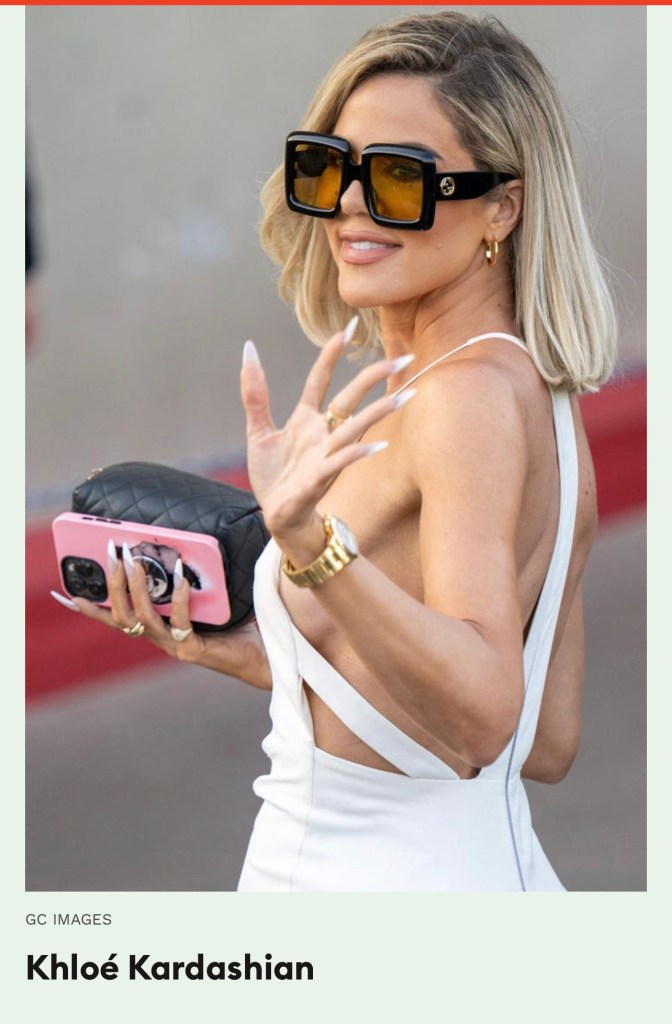




🎶🎶🎶🎶🎶🎶🎶🎶🎶🎶🎶🎶🎶🎶🎶🎶🎶🎶

When Dylan Met The Beatles For The First Time. I’m reporting from the book,“The Last Days Of John Lennon.” I loved this part. —LWH.
Alfred Gilbert Aronowitz, the American rock journalist best known for introducing Bob Dylan to The Beatles in 1964, said it was “the crowning achievement of his career. Brian Epstein, the Beatles manager from 1962 until his death in 1967, arranged for the meeting in the Delmonico Hotel in NYC.
Minutes after meeting each other, Dylan admits to the Beatles that he really likes the line “I get high, I get high” in the song “I Want to Hold Your Hand.”
“Actually,” says John, “it’s ‘I can’t hide, I can’t hide.” Everyone in the room shares a laugh. Then Dylan adds, “Here I was, thinking you were singing about smoking pot.” John and Paul exchange embarrassed glances. “We, ah, haven’t really tried marijuana before.”
Dylan’s road manager, Victor
Maymudes, rolls a joint for each Beatle. “Give it to my royal taster,” John
says, pointing to Ringo. Ringo takes several hits…and can’t stop laughing.
John joins in.
Paul spouts existential phil-
osophy and wanders around hugging people, Ringo and George double over in hysterical laughter, especially when the room phone rings and Dylan answers it with, “This is Beatlemania here.”
“It was such an amazing night,” George later says. “I felt really good. That was a hell of a night.”
🎶🎶🎶🎶🎶🎶🎶🎶🎶🎶🎶🎶🎶🎶🎶🎶🎶🎶
The photo below is of my godson’s son, Lucas. He is far left. Haha. Not sure of his political situation. Nevertheless, this photo makes me so happy, This is the world I want to live in.


Over 25 years celebrating very special, good times with Ruth and Howard Greenberg. Last night they took us to a brand new, glamorous restaurant in the Miami Design District for our birthdays. We had a ball and the food was delicious. Thank you Ruth and Howard. Ruth looked like a fashion model. It made me feel young and optimistic.
🎶🎶🎶🎶🎶🎶🎶🎶🎶🎶🎶🎶🎶🎶🎶🎶🎶🎶


Ruth and Howard topped the evening off for us at an alcoholic ice cream bar called Aubi and Ramsa in the Miami Design District. That was a super celebration treat. See if there is a bar near you. What’s better than eating ice cream and getting a buzz?




🎶🎶🎶🎶🎶🎶🎶🎶🎶🎶🎶🎶🎶🎶🎶🎶🎶🎶


A few hundred folks showed up for Fountainhead Arts Little River studio visit and after party cocktails at Low Key. Many of my favorite artists and collectors showed up. Happy Times



















By Lois Whitman-Hess

If Samsung John Grundy didn’t speak up to the Korean marketing folks in Ridgefield Park, NJ, decades ago, chances are the company would still be making inferior products. I will never forget that day. I was getting berated by the MarCom people my agency, HWH PR, reported to in one of the conferences rooms. The Koreans were very upset with me because I pulled a magazine product review from being published. The editors of the magazine called me to say the product was a dud. They offered to nix the review because they didn’t want to embarrass Samsung and HWH.
I agreed to it. When I delivered the news to Samsung, the executives were furious with me. I will never forget the anger on their faces. After all, Samsung Korea, wanted Samsung United States, to secure product reviews in the big name publications. That was the most important mission assigned to the NJ marketing folks, and I had just ruined one of the first opportunities to make that happen.
I was startled that my clients didn’t understand that a bad review could have been a major setback for the growth of the company. They just kept telling me that I made a wrong decision and how disappointed they were. Their scolding lasted about a half hour when all of a sudden, John Grundy, one of the young American product executives, (who I didn’t even know at the time) stood up and told the MarCom staff how foolish they were. With a stern voice, he explained the ramifications of a bad review and how they should be thanking me instead of verbally beating me up.
The room went silent for about two minutes. It seemed like forever. It was rare, and probably forbidden, for an American executive to question, or criticize, a Korean counterpart, especially in public. Grundy didn’t care. He couldn’t stand listening to the ignorance. I was thrilled because Grundy was far more respected than I was. We were both trying to do the best for the company,
The MarCom people finally understood the consequences. Soon after that, Samsung established a product quality control department and those folks (from Korea) worked very closely with HWH PR. VP Russ Rowland of HWH was instrumental in helping Samsung win “Editors Choice Awards” for years to come. This new department was so thankful to HWH for helping them achieve greatness that they would issue us bonus checks twice a year. We continued to represent Samsung for 17 years.
This is not the first time I have told this story. I have thanked John Grundy a few times but it will never be enough. I know the names of everyone in that room when this situation occurred. I just didn’t feel it was necessary to reveal who they were.
Thank you John Grundy. Thank you Russ Rowland.


💪💪💪💪💪💪💪💪💪💪💪💪💪💪💪💪💪💪

https://www.nytimes.com/2022/11/08/us/politics/trump-desantis-2024.amp.html
💪💪💪💪💪💪💪💪💪💪💪💪💪💪💪💪💪💪

https://amp.cnn.com/cnn/2022/11/09/opinions/outcome-us-2022-midterm-election-roundup/index.htmlf
💪💪💪💪💪💪💪💪💪💪💪💪💪💪💪💪💪💪
“TRUMP IS FURIOUS” AFTER A GOP PINK FLOP—AND A STRONG NIGHT FOR DESANTIS

.

“I was raised in a conservative family. I campaigned door-to-door for Senator John Warner in high school. Later, in the 80s, many of us were caught up in the “trickle-down” economics and bull market of the Reagan era and it was hard to argue against a robust economy. I even worked for The Heritage Foundation at one point in my career.
“But today, I think and feel differently. I believe in what the data says. I trust science. It isn’t perfect, but it’s far better than the instincts and opinions of a population (electorate) that gets much of its unqualified news on YouTube, or Twitter, or TikTok. Misinformation and propaganda are now widespread.
“Democrats, including the Biden administration, have followed the scientists and experts — creating smart, effective policies on climate change, mental health, healthcare and other important issues that are real threats to our society. Ironically, these Democratic policies will help tens of millions of people who claim to be die-hard conservatives.
“I’d like to see a kinder world, one full of tolerance, empathy and understanding. If we truly have empathy, we should all worry about the rights of women, the LGBTQ community, the elderly, children and mental health, the poor, marginalized and underserved communities, and more.
“I worry about social injustices in this country and I am now mindful enough to see the struggles that people of color face — the hate crimes, the hate speech, even the microaggressions. There’s also a growing movement of antisemitism.
“I worry about our human decency and I worry about our democracy. I worry about political violence and the threat of a growing autocracy — centralization of power in the hands of a few. Public office is no longer seen as public service; it’s a means to power, something to be won at any and all costs.
“How could this be happening in the America I grew up in? It was far from perfect, but there was always some semblance of reason and logic, and a sense of community and purpose that I think is missing now.
“So, as much as I try to avoid politics in personal posts on FB, I feel the need to state my opinion. As a country of people, we’re much better than this. As I vote in the mid-term elections, I will vote to save our planet because dire circumstances and events lie ahead if we do not act urgently. I will vote to protect people’s rights. I will vote to preserve equal access to voting, to proper healthcare, and to support a society that conducts itself through love, mutual support, empathy and kindness.
“I will vote for a party that takes its direction from the data and facts, the truth — at least, as well as we can know and understand it. The Republican leaders that garner the most attention today represent the opposite. They encourage us to think, “What’s in it for me?” Democrats ask, “How can we make a better society?”
“While one party seeks to look back and feels regressive, the other — in my humble opinion — seeks to look forward to meet real and dangerous threats that are emerging in the world. That party is more progressive, and it has my full support.”

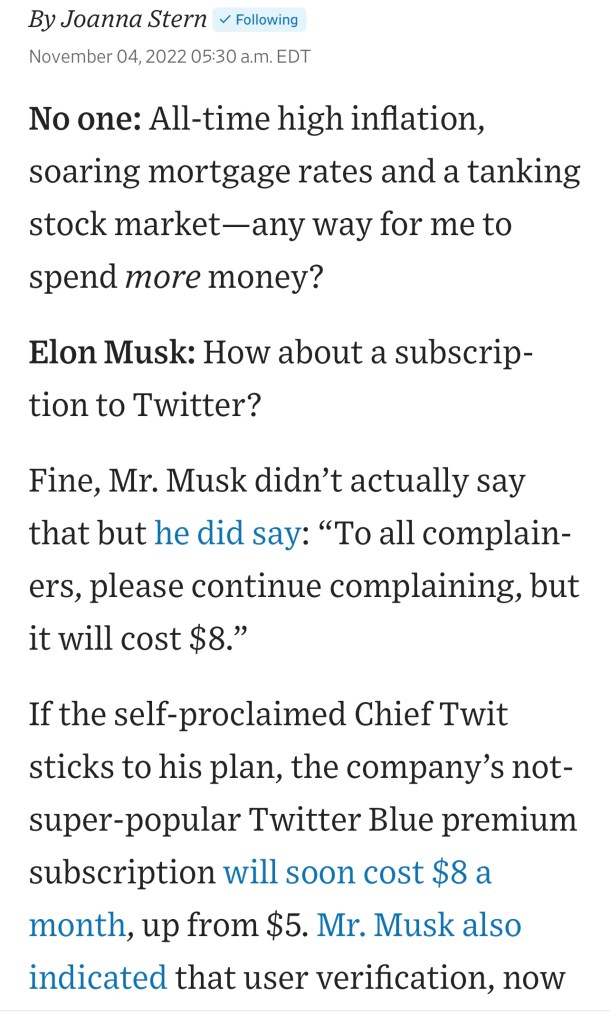










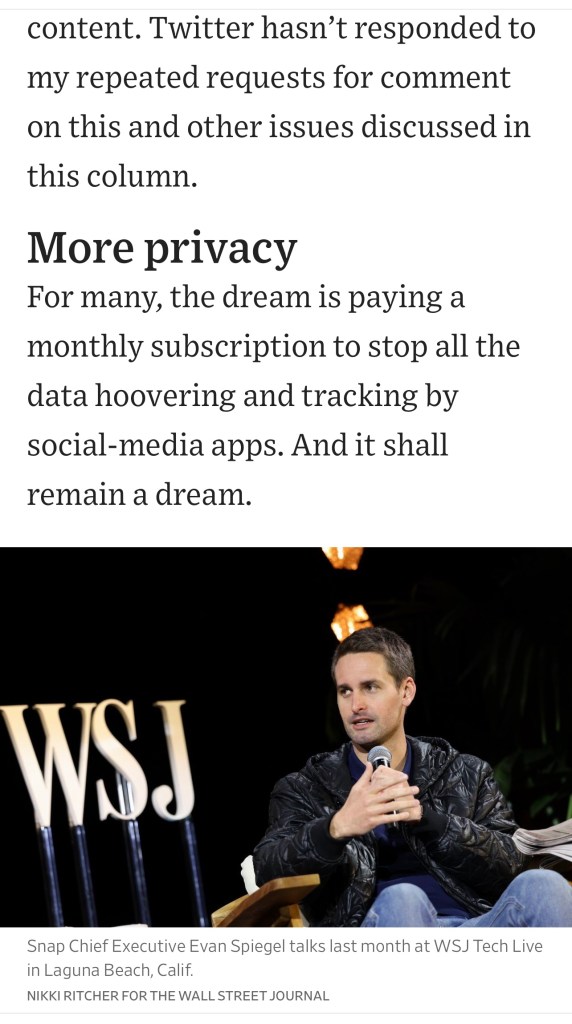


I used to love visiting the Madison Avenue gallery that represented caricaturist Al Hirschfeld. It was a short walk from our apartment building, Margo Feiden was very theatrical looking. She was always very friendly and loved talking about Broadway Stars and Shows. You felt like a Showbiz insider after being in her company. You walked away feeling so energetic and alive. The world needs more people like Margo. RIP. —LWH
She handled the sales of the great caricaturist’s works and told stories of flying Diane Arbus in her plane and encountering the woman who shot Andy Warhol.



By Neil Genzlinger and Alex Traub
Oct. 28, 2022
The scene on a recent Friday at a Greenwich Village townhouse was like a cross between an art opening and a rummage sale.
On the sidewalk, a barker urged passers-by to take a look. Inside the townhouse, a five-story mansion on East Ninth Street on the market for nearly $11 million, the wares included signed prints by the caricaturist Al Hirschfeld — elegant line drawings of Frank Sinatra, Jerry Seinfeld and dozens of others selling for thousands of dollars — as well as a plastic tub of electrical wiring, a heated massage cushion, a pair of 1998-edition Happy Holidays Barbies, and boxes of worn hats and purses.
Overseeing it all, somewhat reluctantly, was Jeremy Rosen, who for weeks has been trying to dispose of what his mother, who died in April in Manhattan, left behind.
She was Margo Feiden, a gallerist best known for the more than 30 years she spent representing Mr. Hirschfeld, the artist famous for his sketches of Broadway luminaries and other stars. Mr. Rosen described himself as “proudly estranged” from his mother, but it had fallen to him to sort through the abundant mix of junk and valuable art she left behind at the townhouse, which was both her home and the latest location of the Margo Feiden Galleries, which she founded in 1969. He said he would continue the estate sale for several weeks.
Ms. Feiden died on April 2 at 77. A report by the city health department listed an array of causes, including cardiopulmonary arrest, pneumonia, urinary tract infection and “failure to thrive.” Though her family placed a paid announcement of her death in The New York Times that month, her passing had gone otherwise unnoted until a Times reader called the estate sale to the newspaper’s attention.
Ms. Feiden occasionally showed other artists at her gallery, including the theater illustrator Don Freeman and the writer Kurt Vonnegut, who dabbled in drawing.
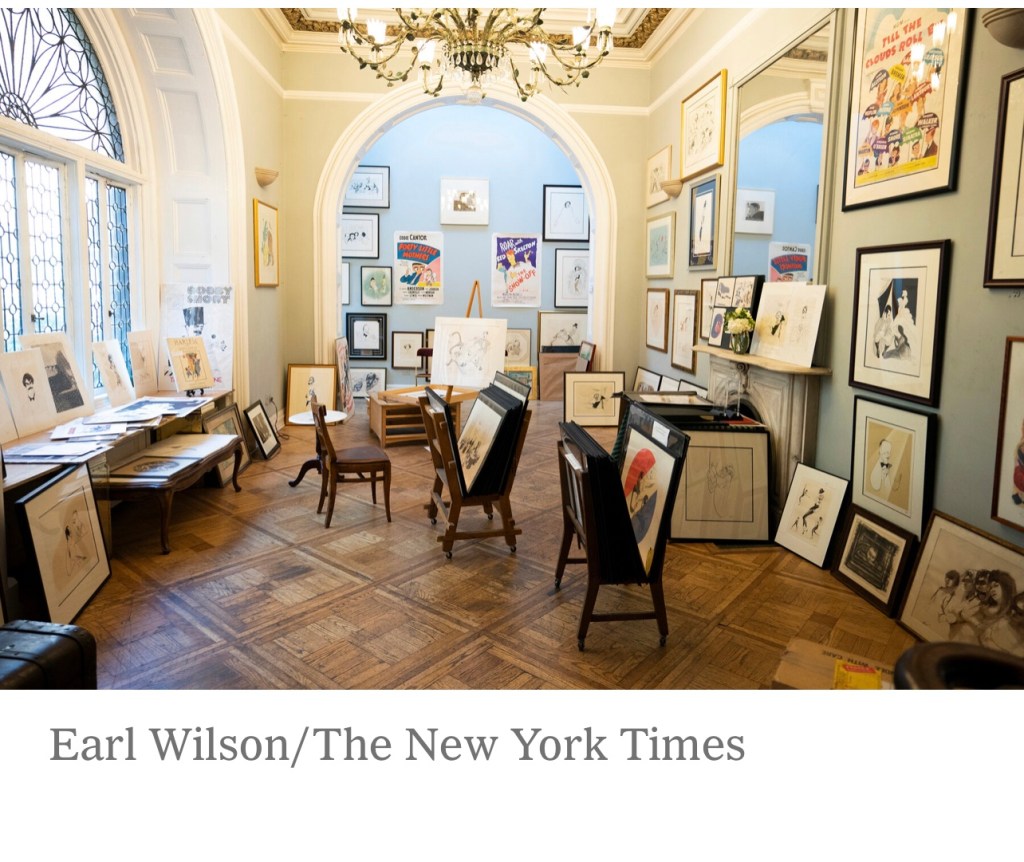
Mr. Hirschfeld, though, was her main client.
As Ms. Feiden told the story to The New York Times in 2000, she met him in 1970, a year after she opened her gallery, when he came in to browse and noticed a photograph of her with an airplane. She told him that she had a pilot’s license and that flying was her hobby. His response, she said, was “Any woman who can fly an airplane can sell my art.”
Her gallery started out on East 10th Street, later had an Upper East Side location on Madison Avenue and ended up back in the Village, on East Ninth Street. There were always Hirschfelds on the walls, but Ms. Feiden also mounted special exhibitions over the years.
For the opening night of a Hirschfeld retrospective in 1985, she had East 10th Street strung with pennants and balloons and positioned vendors on the sidewalk to hand out hot dogs, cotton candy and popcorn. An estimated 1,000 people showed up. A Times reporter covering the evening recorded this exchange.
Mr. Hirschfeld: “I want you to know I had nothing to do with this. She said she was having an exhibition. I didn’t know there was going to be a carnival.”
Ms. Feiden: “I didn’t tell him. I was afraid he wouldn’t have come.”
Mr. Hirschfeld: “She’s quite right.”
For three days in 1991, the Madison Avenue location was declared an official post office in honor of the release of stamps bearing Hirschfeld drawings. Three years later, to mark the 25th anniversary of the gallery, Ms. Feiden had a 40-foot caricature of Mr. Hirschfeld himself painted on the roadway. (Rain came before the sealing topcoat had set, and “he lost about 20 pounds,” she told The Times, though the painters returned to touch up the portrait.)
The Hirschfeld-Feiden relationship went through rough patches, especially in 2000, when Mr. Hirschfeld brought suit against Ms. Feiden, seeking more control over the sale and exhibition of his drawings and asking for more rigorous accounting of sales.
Later that year Mr. Hirschfeld withdrew the suit after reaching a new agreement with Ms. Feiden. Mr. Hirschfeld died in 2003, and 13 years later there was more acrimony: The Hirschfeld Foundation, which mounts exhibitions of his work and supports arts causes, sued Ms. Feiden, claiming that she had violated the 2000 agreement in numerous ways.
The case dragged on for years, with the court siding with the foundation in a series of rulings and awarding several hundred thousand dollars in damages. In 2020, the foundation said in an announcement on its websitethat it had “regained complete control of all of Al Hirschfeld’s work,” and that its relationship with Ms. Feiden was “100% terminated.”

But Mr. Hirschfeld was only one element of Ms. Feiden’s life.
Margo Feiden was born on Dec. 2, 1944, in Brooklyn and grew up in the Flatbush section. Her father, Joseph, was an electrical contractor. Her mother, Jewel (Eliasberg) Feiden, had early aspirations to be an actress before, her daughter once said, becoming a stockbroker later in life.
Ms. Feiden had an early interest in theater. She is said to have produced a production of the musical “Peter Pan” with high school students when she was 16. The next year she staged her own play, “Out Brief Candle.”
Perhaps those early theatrical forays led to a brush with infamy that Ms. Feiden said she had in 1968, though she didn’t tell the story publicly until this century. She said that on June 3 of that year, a woman named Valerie Solanas turned up at her apartment in Crown Heights, Brooklyn, insisting that Ms. Feiden produce a play she had written.
When Ms. Feiden declined, according to an account she gave to The Times in 2009, Ms. Solanas told her that she intended to shoot the artist Andy Warhol, which would make her so famous that Ms. Feiden would certainly change her mind. Another version of the tale, this one in The New York Post in 2018, presented the exchange somewhat differently: Ms. Solanas bluntly told Ms. Feiden, in so many words, that if she didn’t agree to stage the play, she would shoot Warhol.
In any case, Ms. Feiden said that after displaying a gun, the woman left her apartment; later that day, she did indeed shoot Warhol, who was severely injured. Ms. Feiden said she had tried to warn the police and others but was not taken seriously.
Ms. Feiden opened her gallery the next year. Some of the earliest attention she received was for her skill at restoring damaged works on paper. She had begun collecting lithographs and, seeing that many were showing wear, studied up on how to restore them.

In this period Ms. Feiden was also apparently making use of the pilot’s license she had acquired. She told the biographer Patricia Bosworth for her 1984 book about the photographer Diane Arbus that she used to take Arbus on joy rides over Manhattan, flying out of an airstrip on Long Island.
“Diane never spoke during these flights,” Ms. Feiden said. “She seemed mesmerized by the experience and relieved to be off the ground.”
Ms. Feiden’s unusual résumé added another entry in 1989 when she published “The Calorie Factor,” a book she had been researching for a decade, prompted by her own struggle to control her weight. At one point, she said, she hit 300 pounds, but by learning to count calories she shed half of that weight. The book — dozens of copies of which surrounded the entryway to her home during the estate sale — was an extremely detailed listing of how many calories were in which foods.
Ms. Feiden’s marriages to David Rosen and Stanley Goldmark ended in divorce. Her third husband, Julius Cohen, died in 1995. She is survived by a daughter, Bambi Goldmark, and Mr. Rosen.
Mr. Rosen lives in Austin, Texas, and before this year he had not spent much time at his mother’s townhouse. When he came to New York to see his mother in January, he found her home in a state of “squalor,” he said. “By anybody’s definition of ‘hoarder,’ she fit it,” he added.
He was speaking on the street outside his mother’s home. Twice, a garbage truck drove by, and he ran off to hurl a plastic bag of junk into it.
At the same time, Oscar Fuentes, a handyman who acted as Ms. Feiden’s caretaker at the end of her life, called out to anyone he saw on the street, trying to sound as inviting as possible.
“Welcome to our estate sale,” he said. “It’s movies and Broadway history.”
Neil Genzlinger is a writer for the Obituaries desk. Previously he was a television, film and theater critic. @genznyt • Facebook
Alex Traub works on the Obituaries desk and occasionally reports on New York City for other sections of the paper. @alexetraub